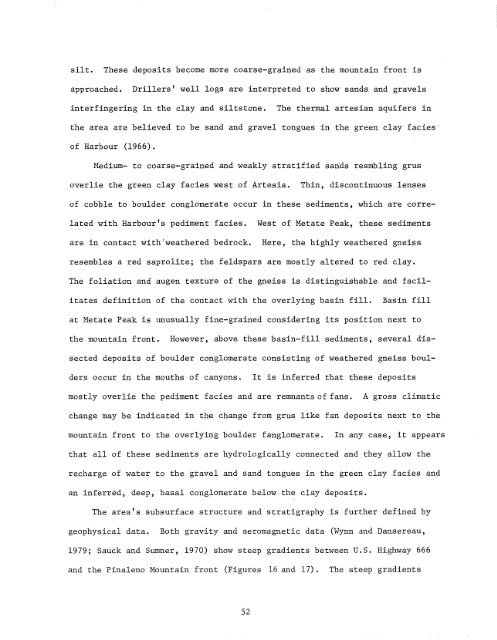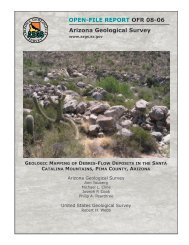geothermal resource potential of the safford-san simon basin, arizona
geothermal resource potential of the safford-san simon basin, arizona
geothermal resource potential of the safford-san simon basin, arizona
You also want an ePaper? Increase the reach of your titles
YUMPU automatically turns print PDFs into web optimized ePapers that Google loves.
silt.<br />
These deposits become more coarse-grained as <strong>the</strong> mountain front is<br />
approached.<br />
Drillers' well logs are interpreted to show <strong>san</strong>ds and gravels<br />
interfingering in <strong>the</strong> clay and siltstone.<br />
The <strong>the</strong>rmal artesian aquifers in<br />
<strong>the</strong> area are believed to be <strong>san</strong>d and gravel tongues in <strong>the</strong> green clay facies<br />
<strong>of</strong> Harbour (1966).<br />
Medium- to coarse-grained and weakly stratified <strong>san</strong>ds resmbling grus<br />
overlie <strong>the</strong> green clay facies west <strong>of</strong> Artesia.<br />
Thin, discontinuous lenses<br />
<strong>of</strong> cobble to boulder conglomerate occur in <strong>the</strong>se sediments, which are correlated<br />
with Harbour's pediment facies.<br />
are in contact with'wea<strong>the</strong>red bedrock.<br />
West <strong>of</strong> Metate Peak, <strong>the</strong>se sediments<br />
Here, <strong>the</strong> highly wea<strong>the</strong>red gneiss<br />
resembles a red saprolite; <strong>the</strong> feldspars are mostly altered to red clay.<br />
The foliation and augen texture <strong>of</strong> <strong>the</strong> gneiss is distinguishable and facilitates<br />
definition <strong>of</strong> <strong>the</strong> contact with <strong>the</strong> overlying <strong>basin</strong> fill.<br />
Basin fill<br />
at Metate Peak is unusually fine-grained considering its position next to<br />
<strong>the</strong> mountain front. However, above <strong>the</strong>se <strong>basin</strong>-fill sediments, several dissected<br />
deposits <strong>of</strong> boulder conglomerate consisting <strong>of</strong> wea<strong>the</strong>red gneiss boulders<br />
occur in <strong>the</strong> mouths <strong>of</strong> canyons.<br />
It is inferred that <strong>the</strong>se deposits<br />
mostly overlie <strong>the</strong> pediment facies and are remnants <strong>of</strong> fans.<br />
A gross climatic<br />
change may be indicated in <strong>the</strong> change from grus like fan deposits next to <strong>the</strong><br />
mountain front to <strong>the</strong> overlying boulder fanglomerate.<br />
In any case, it appears<br />
that all <strong>of</strong> <strong>the</strong>se sediments are hydrologically connected and <strong>the</strong>y allow <strong>the</strong><br />
recharge <strong>of</strong> water to <strong>the</strong> gravel and <strong>san</strong>d tongues in <strong>the</strong> green clay facies and<br />
an inferred, deep, basal conglomerate below <strong>the</strong> clay deposits.<br />
The area's subsurface structure and stratigraphy is fur<strong>the</strong>r defined by<br />
geophysical data.<br />
Both gravity and aeromagnetic data (Wynn and Dansereau,<br />
1979; Sauck and Sumner, 1970) show steep gradients between U.S. Highway 666<br />
and <strong>the</strong> Pinaleno Mountain front (Figures 16 and 17). The steep gradients<br />
52

















